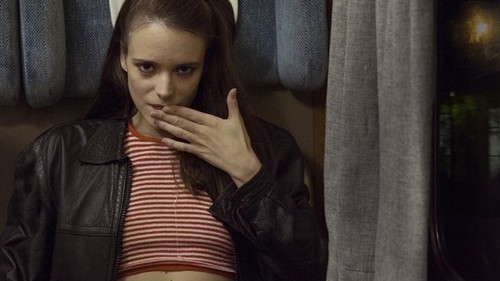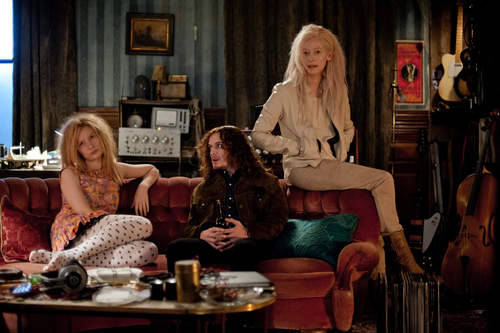Sex, Blood, and a Lust for Life: 3 Film Reviews
If there ever were a good set of bed partners in film it would be Trouble Every Day by Claire Denis, Nymphomaniac I-II by Lars von Trier, and Only Lovers Left Alive by Jim Jarmusch. Despite being graphic, controversial, and outlandish they all deal with accepting who you are – even if you must feed on others to survive.

Still from Trouble Every Day
Recently re-released is prolific french director Claire Denis Trouble Every Day (2001), which was received in the U.S. with mixed reviews (Artforum). The film follows an angst-filled plight of newly-wed American doctor Shane (Vincent Gallo) traveling to Paris with his bride June (Tricia Vessey) in desperate search of a cure for a mysterious cannibalistic disease. As the film progresses it becomes harder and harder for Shane to keep his worsening condition a secret. Denis, with the help of her long-time collaborator cinematographer Agnes Varda, uses visual imagery to conjure changes in mood; close-ups of skin, saliva and bloodied material. Shane’s search is interjected with imagery from Coré’s life, his former lover who suffers from the same disease. Her state is beyond curing. She is locked up in a house by her husband to keep her from seducing men and slowly devouring them in the midst of the sexual act (which happens to a gorgeous young neighbor who breaks an entry and pulls down the boards that keep her in her bedroom). Ranging from loving to distant with his new wife Shane’s quest goes from speaking to various researchers in different labs searching for an antidote. Lab working ethics of not testing the drug on humans contrast with Shane’s nightmarish reality of imagining and enacting gruesome scenes of sex and cannibalistic murder. Although Shane closes the door on his wife to angrily masturbates in his hotel room, rapes a hotel maid, and burns a house down his desperate search for a normal life conjures feelings of sympathy.

Still Nymphomaniac Vol. I
I saw Nymphomaniac Vol. I the day it premiered in New York, and subsequently rushed to see Vol. II when it premiered a week later. Initially I had wanted to see it in Denmark in December (in Europe it is screened in whole). Unlike the other two films (Antichrist and Melancholia), in Lars von Trier’s film trilogy, humanity is portrayed as inherently good, inclusive and versatile. In line with the directors distinctive narrative style where both the character and the plot are contradicted. Gender stereotypes are broken as Joe (played by Charlotte Gainsbourg and Stacy Martin in her younger years) recounts her sexual life to Selingman (Stellan Skarsgård). The man who took her in after finding her beat-up in an alley. The story is spurred by Joe’s curiosity at a young age. Feelings of anger and rebellion to the notion of monogamy in her teens. And finally her attempt to love and subsequent despair at her failure in her later years. As she tells the story she feels an underlying pressing feeling of guilt, for this reason Selingman tries to rectify her behaviour every step of the way often referring to religious texts, music and fishing. Before seeing the film I read Sarah Nicole Prickett’s review in Artforum, and after seeing it was gravely disappointed in it and much other press – mainly due to it’s focus on sex when the films main focus explores the human condition and society’s structures leading to inhibition. Sex is only a catalyst. The film, to me, is inherently inspirational; a young girl taking control of her sexuality is empowering. It is also an interesting exploration of an alternative lifestyle. Although Joe might have feelings of guilt she is not a victim – proven at the end of the film. It ends in a veritable grand finale that left me laughing. I will not spoil for those of you who are going to see it!

Still from Only Lovers Left Alive
Another much anticipated film in my calender was Jim Jarmusch’s Only Lovers Left Alive. The film stars Tom Hiddlestone and Tilda Swinton as unbearably cool bohemian vampires living under the pretense of dealing with toxic blood due to the evolution of healthcare and their love-driven marital union. Jarmusch allows us to follow Hiddlestone’s character, a plagued depressive musician stuck in the past living in a derelict house filled with antique objects in Detroit. And Swinton, who when she receives a phone call from her lover in need picks a selection of books and leaves her small room in Marrakesh to meet him in Detroit. Like in Nymphomaniac Swinton and Hiddlestone were on different sides of the spectrum in their understanding of life; Swinton inherently embraced it while Hiddlestone lived with reluctance and only through support from and because his love for Swinton. The film was however lacking, the characters didn’t evolve and the monogamous love-story governed by religion (marriage, at one point in the film they look at a 19th century photograph and reminisce their wedding day) is extremely boring, at least without the objectification of the male body (Twilight, yum). I suppose it is pretty obvious that characters that live forever without being decadent and without being penetrated by moral decadence make dull characters. Too bad Swinton’s bad-girl sister played by Mia Wasikowska didn’t play a larger role.
Nymphomaniac, Trouble Every Day and Only Lovers Left Alive all explore human kinds varying lust for life, curiosity and the tensions between imposed and chosen life-styles.
What's Your Reaction?
Anna Mikaela Ekstrand is editor-in-chief and founder of Cultbytes. She mediates art through writing, curating, and lecturing. Her latest books are Assuming Asymmetries: Conversations on Curating Public Art Projects of the 1980s and 1990s and Curating Beyond the Mainstream. Send your inquiries, tips, and pitches to info@cultbytes.com.

